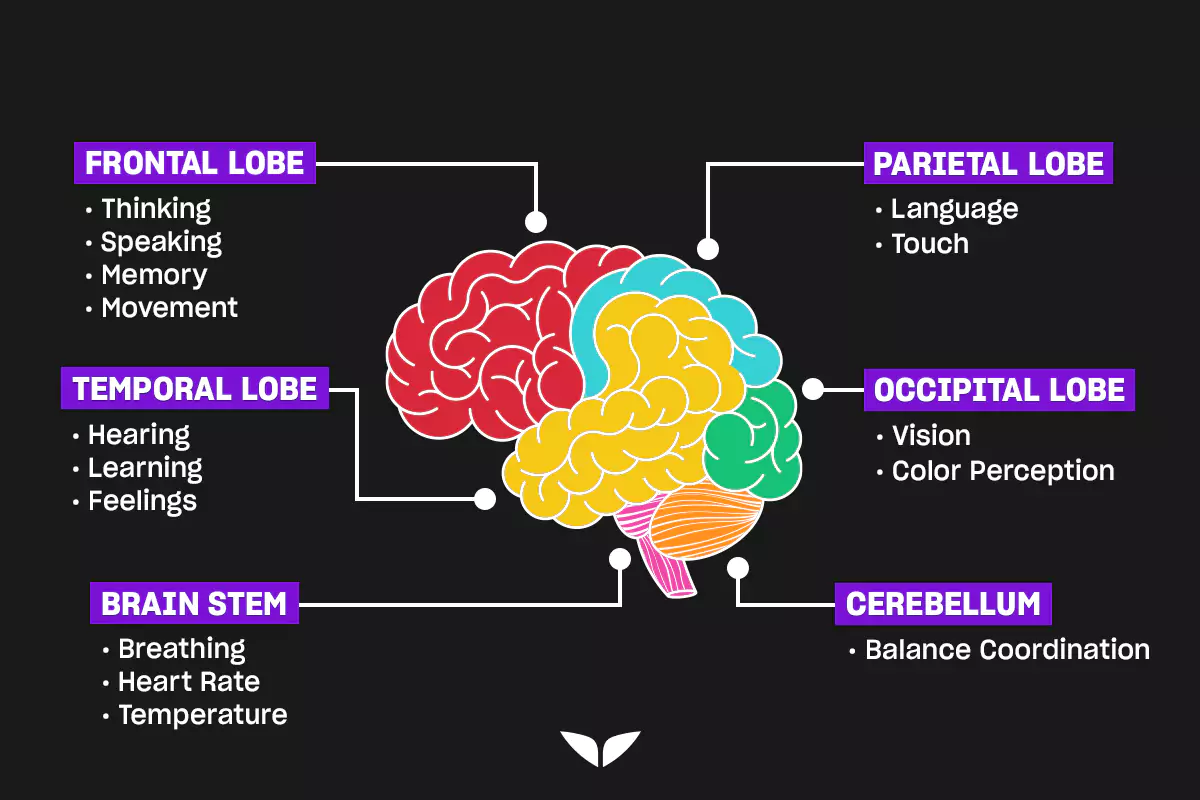Of your brain’s four main regions, the brain stem function probably plays the most vital role of all. Your brain as a whole, along with your body’s vital organs, all rely on healthy brain stem function.
Located just above the spinal cord, the brain stem connects the spinal cord with the brain and consists of the midbrain, pons, and medulla oblongata. Along with other brain regions, the brain stem plays an integral part in many vital processes, including breathing, digestion, and movement.
To get an understanding of how important its role really is, consider this analogy:
A tree and all its branches and leaves represent your brain, body, and vital organs. The tree trunk represents your brain stem. Without the tree trunk, everything else will, over time, shrivel away and die.
That’s how important it is!
In this article, we’ll take a deeper look at the function of the brain stem and explain how this region of the brain helps your whole body function well.

About the Brain Stem: Function and Injury
Let’s start by answering that basic question that all the science googlers out there want to know.
Why is the brain stem important?
Many experts believe that the brain stem is the most important part of the brain. To put it simply, the brain stem acts as a connection cable, allowing connected nerves to send signals from your brain to the rest of your body.
Similar to the tree trunk example that we gave in our intro, the brain stem is basically the vital connection that keeps everything in functioning order. Without it, your brain can’t communicate and send signals to the rest of the body, and vice versa.
What is the function of the brain stem?
To get a well-rounded picture of all the brain stem functions, we’ll need to learn what parts the brain stem connects to.
The brain stem acts as a primary connection to several parts of the brain. In a way, it can be considered a control bridge between brain parts.
It links the cerebrum and spinal cord together, as well as the cerebrum with the cerebellum. The cerebellum is positioned right above the brainstem and beneath the occipital lobes at the back.
Within the brainstem are nerve tracts that relay signals from the cerebellum to areas of the cerebral cortex. This allows you to have fine coordination and control of your motor movements.
Other important brain stem functions also include:
- Alertness
- Breathing
- Blood pressure control
- Digestion
- Heart rate
- Information bridge between the peripheral nerves and spinal cord to the upper areas of the brain
The brain stem is not just a connection between different areas of the brain. It also acts as your body’s management control, regulating many of its autonomic functions.
What does the brain stem regulate?
In addition to serving as a bridge between the brain and the spinal cord and relaying information to all other parts of the brain, the main function of the brain stem is to regulate your body’s autonomic functions like breathing and digestion.
The brain stem regulates many of the functions in your body that are essential for you to live, such as your breathing, heart rate, blood pressure, and your central nervous system.
You may be thinking, “But I can control my breathing and heart rate if I want to by running.” Yes, you can manipulate them yourself by going for a jog, but you don’t actually tell your heart rate to go up or your breathing to get heavier.
That process to keep you alive is controlled by your brainstem in reaction to your running. That is precisely why it’s vital for sustaining life.

What are the three functions of the brain stem?
As you can see, the brain stem has a wide range of functions that help your body operate.
If you look closely at the structure of the brain stem, you’ll notice that it looks much like an actual stem, while the cerebrum looks like a flower growing from it. Underneath them is the spinal cord, which can be observed as the root.
It consists of three major divisions: the medulla oblongata, the pons, and the midbrain.
1. The medulla oblongata
Controls a wide range of involuntary processes like breathing, heart rate, and digestion. Also manages reflex behaviors, like vomiting, swallowing, coughing, and sneezing.
2. The pons
Deals with sensations from the head, face, movement of the eyes, and mouth. It also aids in balance.
3. The midbrain
Gathers sensory information related to eye movements, and visual and auditory processing, and is involved in movement, motivation, and reward.
Can you recover from a brain stem injury?
Damage to some parts of the brain can be managed, however, brain stem injuries can be very difficult and fatal to your overall health. It can even potentially cause permanent damage.
That’s because the brain stem connects your brain to all other parts of your body. Without a brain stem, that connection would be lost, and your body couldn’t function.
Injuries to the brain stem can affect your personality and even paralyze you. Since this is a very sensitive part of the brain, today’s treatment is limited and very expensive.
It’s not about mental intelligence, it’s about mental fitness.
— Jim Kwik
It’s not all bad news when it comes to treating brain stem injuries. As long as the injury is diagnosed early enough, it can be, in many cases, highly treatable.
Depending on the nature of the injury, of course, and what areas of the body are affected, specific exercises and therapy can help strengthen the brain stem’s function.
Like any other muscle in your body, your brain, including the brain stem, grows and develops with regular exercise. This includes both actual physical exercise and brain workouts.
Together, they stimulate the generation of new neurons and help keep your brain young and active.








